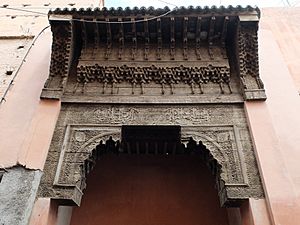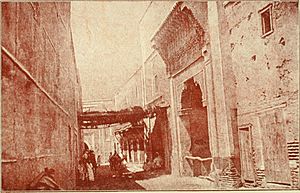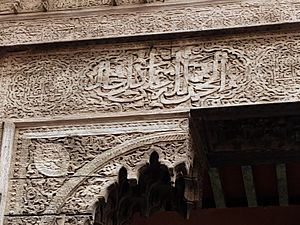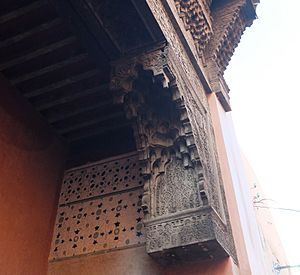Shrob ou Shouf Fountain facts for kids
Quick facts for kids Shrob ou Shouf Fountain |
|
|---|---|
 |
|
| Type | Fountain |
| Area | Marrakesh, Morocco |
| Built | late 16th or early 17th century |
| Architectural style(s) | Saadian, Moroccan, Islamic |
The Shrob ou Shouf Fountain (also known as Chrob ou Chouf Fountain) is a historic wall fountain located in the old city, called the medina, of Marrakech, Morocco. It was built a long time ago, either in the late 1500s or early 1600s. You can find it close to the famous Ben Youssef Madrasa. Its name means "drink and look" in Moroccan Arabic, inviting people to enjoy the water and admire the fountain's beauty.
Contents
A Glimpse into History
When Was It Built?
This beautiful fountain was built during the time of the Saadi dynasty, a powerful family that ruled Morocco. Marrakech was their capital city back then. The Shrob ou Shouf Fountain looks a lot like other fountains built by the Saadian rulers, such as those at the Mouassine Mosque and Bab Doukkala Mosque.
We don't know the exact date it was built or who ordered it. However, some people believe it was made during the reign of Ahmad al-Mansur, who was a sultan (ruler) from 1578 to 1603.
What Does the Name Mean?
The name of the fountain today, "Shrob ou Shouf," means "drink and look" in Moroccan Arabic. This name suggests that people should not only drink the water but also take a moment to admire the fountain's beautiful design and details.
What Does the Fountain Look Like?
The Shrob ou Shouf Fountain is built like a simple, large alcove or open space in a wall. This space protects the area where people could get water. Old photos show that this space used to be deeper. It even had a basin at the bottom to hold water. There was also a wooden bar across the entrance. This bar was there to stop animals, like donkeys or horses, from drinking the same water as humans.
However, over time, the fountain has changed. It seems the back wall was moved forward, making the space shallower. Because of this, some of the original parts, like the water basin, are no longer there.
The Decorations
The lower part of the fountain, near the ground, is quite plain. But above this, the fountain is covered by a beautiful canopy made of finely carved palm wood. This carving style is typical of Moroccan-Andalusian or Moorish design.
Much of the canopy is covered with detailed patterns called arabesques, which are swirling designs inspired by plants. Many parts of the wood are also carved into a "honeycomb" style, known as muqarnas. The way this canopy is shaped and decorated is very similar to other Saadian wall fountains from the same time. You can see similar designs at the Saadian Tombs and in the courtyards of the Qarawiyyin Mosque.
Above the main opening, there are two almond-shaped designs. These might have been influenced by the Ottoman Empire. Carved into the wooden beam above the opening are two special sections with Arabic writing. This writing is in a fancy style called thuluth and praises God. The words roughly translate to: "The most beautiful words that have been said are: praise to God in all circumstances!" You can find the exact same words on other fountains from the same period, like those at the Mouassine and Bab Doukkala mosques.
At the very top, the wooden canopy sticks out over the street like a wide ledge. The roof of this ledge is covered with green tiles, adding another touch of beauty to the fountain.
See also
 In Spanish: Fuente Chrob ou Chouf para niños
In Spanish: Fuente Chrob ou Chouf para niños
- Mouassine Fountain
- Ben Youssef Madrasa
- Saadian Tombs
- El Badi Palace




